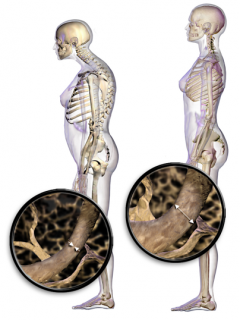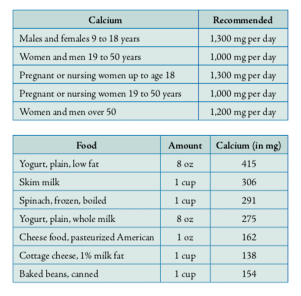Osteoporosis is a silent and very debilitating disease. If you want to age in good health and vitality, then you have to take active steps to guard against it. 20th October 2020 is World Osteoporosis Day. It marks a year-long campaign dedicated to raising global awareness of the prevention, diagnosis, and treatment of osteoporosis.
Why is osteoporosis so tough on your bones as you age?
Osteoporosis itself is silent with no expressions or indications that it exists. The number one problem is the increased risk of bone fractures. Osteoporotic fractures occur in situations where healthy people would not normally break a bone; they are thus labeled as fragility fractures. Fragility fractures appear in the spine bones called vertebrae, rib, hips, and wrist.
 Compression fractures
Compression fractures
A compression fracture is not a fracture where the bones are cracked into two pieces. The vertebrae may collapse from above and below. Typically, patients complain about sudden onset back pain. Some people develop radicular pain. With time, progressive collapse, and involvement in more spine bone fractures, people tend to stoop forward, experience a loss of height and develop pain.
You can test for osteoporosis to ensure early detection
Ask your doctor for a dexa scan. For women over 65 and men over 70, DEXA scans are only appropriate for those with a moderate risk of fracture or when the results will change the patient’s care plan. Younger women and men ages 50 to 69 should consider the test if they have risk factors for serious bone loss. This test shows your bone mineral density.
What is osteopenia?
Osteopenia is a condition that begins as you lose bone mass and your bones get weaker. This happens when the inside of your bones become brittle from a loss of calcium. It is very common as you age. Total bone mass peaks around age 35. People who have osteopenia are at a higher risk of having osteoporosis. Osteoporosis is a bone disease that occurs when the body loses too much bone, makes too little bone, or both. As a result, bones become weak and may break from a fall. In more serious cases, bones may break from sneezing or minor bumps.
Prevention of osteoporosis
It’s important to become aware early. Prevention of osteoporosis should ideally begin in childhood, aiming to achieve high peak bone mass and overall a healthy lifestyle throughout life. Awareness of osteoporosis and its problems could lead to taking the steps necessary to prevent stooping, fractures, and pain.
In order to prevent bone loss during the middle ages and avoid late-stage fractures, one must also consider safety. Great bones are made by paying attention to calcium and vitamin D intake, the pounding of weight-bearing exercise, and strength training.
Falls are the biggest risk factor
Falls are the biggest risk factor and can be prevented with house modifications and exercises aimed at balance and agility. Therapeutic intervention in the late ages is recommended, such as grabbing rails and not loose carpets. International and national strategies are present throughout social media which are aimed at common mistakes and identification of those risks.
Check your vitamin D levels
Ask your doctor to check your vitamin D levels. Worldwide, more than 50% of the population is vitamin D deficient. The American Academy of Orthopedic Surgeons and recent research support that the body needs at least 1000 international units per day for good health – depending on age, weight, and growth. In general, babies (especially mothers who are breastfeeding) and small children should intake at least 400 IU of Vitamin D daily. Children over age 5, adolescents, and adults should get a minimum of 1000 IU of Vitamin D each day. Check with your medical doctor to assess your levels with a blood test.
 Who is at risk?
Who is at risk?
You may be at risk for vitamin D deficiency if you:
- shun the sun
- have milk allergies
- follow a strict vegetarian or vegan diet
Low blood levels of vitamin D have been associated with:
- an increased risk of death from cardiovascular disease
- severe asthma in children
- Cognitive impairment
- cancer
Research suggests that vitamin D could play a role in the prevention and treatment of
- type1(juvenile) and type2 (adult-onset) diabetes
- hypertension
- glucose intolerance
- multiple sclerosis
Here’s why you need calcium to combat osteoporosis
Calcium is critical to the making of bones. The table shows recommended dosages and sources.
Check your calcium levels

Why good posture is very important
Todd Snyder, Physical Therapist explains, ” simply put, good posture is the proper alignment of the spine. Optimal alignment leads to the most efficient position to carry the spine. Misalignment of the spine leads to increased forces seen by the spine. Over time, misalignment can lead to tons of pounds of force placed upon the spine each year. Proper posture and alignment of the spine compound positively over the years.”
Walking is a weight-bearing exercise
According to Gregory James Chiaramonte, M.D. walking in all forms is beneficial. Walking builds strong bones, promotes mental clarity, and it involves the use of the heart and lungs. It also promotes facet joint mobility, nerve root mobility, and function.
Better bone health as you age
Uphill walking is different in that the spine joints are in a flexed open position. This might be helpful in conditions where there is nerve root tightness. Uphill walking may even help patients with spinal stenosis and other ailments because it opens up the spinal channel. Downhill walking is different since the spine joints are in an extended closed position. This could worsen conditions where there is already nerve root tightness. The spinal channel tends to close as well.

Bottom Line
As you age, you need to be aware of osteoporosis risk. This is a debilitating disease and prevention is the best way to mitigate risk as you get older.
Read more on how to ensure good bone health[/vc_column_text]
About the Authors
By Ken Hansraj, M.D.
 Kenneth K. Hansraj, M.D., is a spinal and orthopedic surgeon specializing in cervical, thoracic and lumbar procedures, bloodless spine surgery, minimally invasive spine surgery, laminectomies, and spinal fusions. He believes in whole-body wellness and preventative care. He also believes that the spine is a principal indicator of general health impacted by “human software and hardware.”
Kenneth K. Hansraj, M.D., is a spinal and orthopedic surgeon specializing in cervical, thoracic and lumbar procedures, bloodless spine surgery, minimally invasive spine surgery, laminectomies, and spinal fusions. He believes in whole-body wellness and preventative care. He also believes that the spine is a principal indicator of general health impacted by “human software and hardware.”
A life passion
Dr. Hansraj earned his medical degree from Hahnemann University School of Medicine in Philadelphia in 1987. He did this after obtaining graduate studies in biological sciences from Columbia University, New York. What’s more, he also obtained an undergraduate degree in biological sciences from Fairleigh Dickinson University, New Jersey. He completed his general surgery and orthopedic surgery residency training at Mount Sinai Hospital and King/Drew Medical Center. During this time, he completed a Fellowship in Orthopedic Biomechanics at The Hospital for Special Surgery, NY. Dr. Hansraj held a Fellowship at the California Center for Minimally Invasive Spinal Surgery and a Fellowship for Spinal and Scoliosis Surgery at the Hospital for Special Surgery, New York.
Today, with more than two decades of surgical experience, Dr. Hansraj has seen and treated more than 20,000 patients. He has come to recognize and promote the critical importance of the cervical spine as it relates to overall physical and mental well-being.
Keys to an Amazing Life: Secrets of the Cervical Spine
He is the author of the forthcoming book, Keys to an Amazing Life: Secrets of the Cervical Spine, (January 2013). He was inspired to write a book based on this concept. Dr. Hansraj is also the author of Bloodless Spine Surgery: Pictures and Explanations. His goal with each of his books is to bring years of accumulated expert medical knowledge to the public at large. He does this in an easy-to-digest format to help countless individuals with ongoing spinal and health issues.
Dr. Ken is a spinal surgeon at Nuvance Health based at The Vassar Brothers Medical Center in the Hudson Valley, NY.
He is board-certified by:
- the American Board of Orthopaedic Surgery
- the American Board of Minimally Invasive Spinal Medicine and Surgery and
- the National Board of Medical Examiners.
Christian Campilii, D.P.T.

Christian D. Campilii PT is a male physical therapist in Wappingers Falls, NY with over 30 years of experience. The procedure that Christian Campilii most frequently performs is Physical Therapy Exercises. Christian Campilii graduated in 1990. He is licensed to practice with the state board in New York. Chris is the founder and managing partner of the Center For Physical Therapy. Chris supervises CPT’s teaching program for PT students from various universities. He works closely with local athletes and is known for his sound advice. He lectures on orthopedic injuries and preventative techniques. Chris routes for his alma mater, Notre Dame.
Pilates is an excellent exercise to create core strength and help your body get stronger. You can do these Pilates exercises at home.



 Who is at risk?
Who is at risk?![women [longevity live]](https://longevitylive.com/wp-content/uploads/2020/01/photo-of-women-walking-down-the-street-1116984-100x100.jpg)










